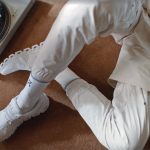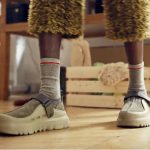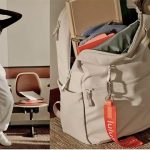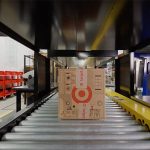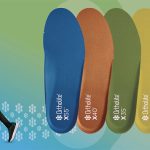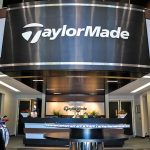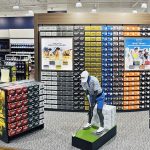Hanesbrands, Inc. management put a bit of a smiley face after a tough second quarter report for their key Champion brand and used the word “pleased” frequently as company CEO Steve Bratspies commented on a conference call with analysts regarding the company’s overall Q2 performance.
The CEO said he was pleased that revenue, operating profit and earnings per share were in line with their internal outlook. He said they were also pleased that several of the company’s key performance metrics are improving, and then reaching deep to find an upside for the year-over-year decline in gross margin to highlight the fact that they delivered 90 basis points of sequential gross margin improvement versus the first quarter.
But HBI did have some real wins as well, outlining the efforts to reduce inventory, achieving a year-over-year reduction of $255 million, or 12 percent, decline from the year-ago quarter-end. HBI also generated positive operating cash flow for the quarter and year-to-date, and because of the strong cash generation, they began paying down debt earlier than expected. And the U.S. Innerwear business delivered a strong quarter, with results that were ahead of expectations, including sales growth of 3 percent over last year and 440 basis points of sequential margin improvement.
“We delivered solid results for the quarter despite the increasingly challenged consumer environments in Australia and the activewear apparel market in the U.S.,” said company CFO Scott Lewis. “Revenue, operating profit, EPS, as well as gross and operating margins were all in line with our outlook. What stood out to me in the quarter’s results was the continued progress we made on reducing inventory and unlocking working capital.”
Global Champion brand sales decreased 16 percent year-over-year on a reported basis, with a 25 percent decline in the U.S. and a 1 percent decline internationally. In constant-currency terms, Global Champion brand sales decreased 15 percent, with international consistent with the prior year. The constant-currency sales decline was said to be driven primarily by challenging activewear market dynamics and the near-term impact from the company’s strategic brand-related actions in the U.S.
Overall Activewear segment sales declined 19 percent year-over-year to $267.5 million as ongoing headwinds within the overall activewear category, including soft consumer demand and excess channel inventory, combined with the company’s strategic brand-related actions continued to impact Champion sales in the U.S. Continued growth in the collegiate channel was more than offset by declines in other channels.
U.S. Activewear sales and operating profit were said to be below internal expectations. Growth in Champion Asia and stable performance in Champion Europe essentially offset the decline in the Australia business, which was said to be driven by a very challenging macroeconomic environment.
Looking at the Activewear segment business in the U.S., second-quarter sales reportedly declined 19 percent compared to last year’s Q2 as Champion sales continued to be impacted by “a combination of challenging category dynamics and the strategic brand-related actions” Bratspies said they were taking to drive stronger brand health through a more disciplined channel and product segmentation approach.
“The combination of soft category dynamics and the near-term impact from our strategic brand-related actions continue to weigh on Champion U.S. sales,” shared Bratspies. “Looking at the rest of the year, the headwinds impacting our Australia and U.S. Activewear businesses have increased, which is the primary driver for our adjusted outlook for the second half. That said, we remain on track for strong margin recovery and we expect to exit the year with gross margin in the high 30 percent range, to generate $500 million of operating cash, and to pay down more than $400 million of debt.”
On the call, Bratspies laid out a progress report on the company’s Full Potential strategy, beginning with the Champion business.
“Champion is a great brand,” Bratspies said confidently. “It is over 80 percent domestic and 65 percent global awareness and a significant global growth opportunity. We’ve made solid progress on improving the operations and processes within the Champion business that position us for future growth. However, the timing of these actions translating to financial results has been mixed.”
In Asia, where the brand is said to be the most advanced in terms of product and channel segmentation, he said they are experiencing strong growth. In Japan, he pointed to the combination of new product launches and the ramp-up of a loyalty program are driving strength in their retail business. In China, Bratspies said they continue to work with their partners to open new stores, launch new footwear franchises and develop localized product and marketing to build a strong foundation for future growth.
In Europe, he said that despite the macroeconomic headwinds, the business is stable.
“We’ve seen solid performance within our retail business, our footwear business continues to build momentum, and we’re leveraging our global scale by bringing our top-performing styles to the U.S. This performance is balanced against the headwinds we’re seeing in wholesale, as retailers take a more cautious approach to fall/winter orders.” Bratspies shared.
The conversation around the U.S. had a different flavor.
“In the U.S., Champion is not where we expected it to be at this point in time,” the CEO continued. “This is clear in our results and our outlook. And as a result, we’re actively taking steps that we believe will drive the long-term success of the brand. We’ve brought in new leadership, which is driving new talent in design, merchandising and sales. We’ve coordinated and launched our new brand purpose of Champion a better tomorrow.”
He said they have completed the first full global product line from the new team, which is based on their “disciplined global segmentation approach,” and will be available for the 2024 fall/winter selling season.
“In total, nearly one-third of our 2024 product and fabric platforms will be global versus zero today. This will reduce SKU complexity and drive additional cost savings beginning next year,” he estimated.
Bratspies also said they have streamlined their supply chain operations, including balancing third-party sourcing and internal manufacturers, consolidating sourcing partners, and shifting to dedicated Champion DCs.
“We’re taking the necessary steps of shifting our channel mix in the U.S.,” he continued. “This is a big initiative that is taking longer than expected due to the category and channel inventory headwinds. It’s the right thing to do for the brand for the long term, and we’re receiving very positive feedback from our retail partners.”
“When you think about the channels, when you think about activewear in general, there’s still inventory out there in the channel,” Bratspies said in answer to a question regarding inventory. “I think it’s slowing things down and causing some pressure. If you look at the recent growth in the activewear channel, it’s been declining and that’s been accelerating right now. Some of that is driven to the backup in inventory right now. Now, we’ve taken a lot of inventory actions that positioned us extremely well to manage through the slowdown in the channel. If you remember last year, the time out that we took, we moved quickly to take action against inventory, which I think positions us well this year.”
Bratspies went on to say during the Q&A period that sales in the U.S. are going to remain pressured through the back half of this year. “Fundamentally, we have to improve our product segmentation,” he explained. “We have to improve our product performance. We’re seeing soft POS right now in a challenging category as we go forward. That’s the work that we need to do that we really need to focus on.”
But Bratspies emphasized that the focus for HBI and Champion in managing the individual channels to balance what they sell where not exiting specific channels like off-price.
“I would tell you, a couple of years ago, I think we got away from that. We weren’t disciplined and we weren’t thoughtful enough in individual channels. Now we’re putting a very clear model in place to understand what product goes where and when. And if we do that, I think we’ll be very effective. That has been well received by all of our retail partners.
“In terms of the channels that we’re moving, it’s more about balancing the mix of channels, more than exiting channels directly,” he explained. “We are really working on a very specific channel segmentation strategy and having a strong discipline behind that segmentation strategy. Off-price is an important channel. It plays a key role. It needs to be managed appropriately and have a very purposeful strategic role. And if we do that across all our categories, I think we’re going to be in good shape.”
The operating loss for the Activewear segment was $4.0 million for the quarter, compared to $5.3 million in operating profit in the prior-year quarter. Operating margin for the segment was negative 1.2 percent, compared to 6.9 percent in Q2 last year, decreasing approximately 810 basis points. HBI said the decline was driven by the impact from lower sales volume, unfavorable mix, input cost inflation and higher reserves as compared to last year due to higher inventory levels at retail. These headwinds were said to more than offset the benefit from cost savings initiatives as well as lower variable expenses.
In addition to the natural margin recovery Bratspies said they expect next year from lower input costs and the benefits of using global product platforms, he said they have also taken recent additional actions to improve Champion’s performance in the U.S.
“We quickly opened seven pop-up Champion stores to move through excess inventory in a way that preserves margins and brand equity,” he said. “We’ve established partnerships with industry-leading licensees for kids’ apparel and outerwear, with the potential for additional categories. We’re also beginning to leverage our successful performance in the collegiate channel by using our quick-turn graphics capabilities to drive incremental revenue opportunities in our wholesale business.”
He said they remain highly confident in the potential of the Champion brand, but they also expect brand sales in the U.S. to continue to be pressured throughout the rest of the year.
“We’re proud of these achievements, but there’s work left to be done and we’re taking action,” he concluded in his prepared remarks.
It’s always good to go from “pleased” to “proud.” That sounds like an opportunity.
* * * * *
Consolidated Corporate Results
Hanesbrands reported that net sales from continuing operations decreased 5 percent to $1.44 billion in the second quarter ended June 30, including an $18 million unfavorable impact from foreign exchange rates. On a constant-currency basis, net sales decreased 4 percent, with growth in U.S. Innerwear and Champion in Asia more than offset by the decline in U.S. Activewear and the continued macro-driven slowdown in consumer spending impacting Australia.
Consolidated company gross margin declined 430 basis points year-over-year to 33.5 percent of sales in Q2. Adjusted Gross Margin of 33.6 percent, which excludes certain costs related to the company’s Full Potential transformation plan, increased approximately 90 basis points from first-quarter 2023 and declined approximately 425 basis points compared to second-quarter 2022. HBI said headwinds from commodity and ocean freight inflation represented approximately 245 basis points of year-over-year margin headwind in the quarter as the company continues to sell through its higher-cost inventory. Additional headwinds in the quarter were a business mix, including a lower DTC mix, as well as higher labor rates. Partially offsetting the margin headwinds in the quarter were benefits from lower air freight expense as compared to last year and cost savings initiatives.
SG&A expenses declined 3 percent to $413 million as compared to last year’s comparable quarter. Adjusted SG&A expenses, which exclude certain costs related to the company’s Full Potential transformation plan, declined 6 percent, or more than $23 million, year-over-year to $396 million. The year-over-year decline in adjusted SG&A was driven by benefits from cost savings initiatives, particularly in distribution, disciplined expense management, as well as lower variable expenses, including selling and marketing. As a percent of net sales, adjusted SG&A expense of 27.5 percent of sales decreased 20 basis points from the prior-year period as cost controls and expense efficiencies more than offset the fixed cost deleverage from lower sales.
Operating Profit and Operating Margin in the second quarter of 2023 were $69 million and 4.8 percent, respectively, compared to $147 million and 9.7 percent, respectively, in the prior-year quarter. Adjusted Operating Profit of $87 million declined from $154 million in the second quarter 2022. Adjusted Operating Margin of 6.1 percent declined approximately 405 basis points from the prior-year quarter.
Interest and Other Expenses for the second quarter of 2023 were $82 million as compared to $36 million in the prior-year period. This increase was said to be driven by higher interest rates on higher debt balances.
Tax Expense for second-quarter 2023 was $10 million. For the second quarter 2022, the tax expense and adjusted tax expense were $19 million and $20 million, respectively. Effective Tax Rate for the second-quarter 2023 was (80.2) percent. For the second quarter 2022, the effective tax rate and the adjusted effective tax rate was 17.0 percent. The company’s effective tax rate for the second quarter 2023 is not reflective of the U.S. statutory rate due to valuation allowances against certain net deferred tax assets.
Loss from continuing operations totaled $22 million, or a loss of 6 cents per diluted share, in Q2. This compares to income from continuing operations of $93 million, or 26 cents per diluted share, in Q2 last year. Adjusted loss from continuing operations totaled $4 million, or a loss of 1 cent per diluted share. This compares to adjusted income from continuing operations of $98 million, or 28 cents per diluted share, in the second quarter 2022.
Third-Quarter and Full-Year 2023 Financial Outlook
With respect to the company’s 2023 guidance, HBI’s outlook reflects, but is not limited to, the following assumptions: a muted consumer demand environment given the continued macroeconomic uncertainty, including increased pressure in Australia and the U.S. activewear apparel market; and year-over-year improvement in second-half margins, particularly the fourth quarter, as lower-cost inventory currently being produced is sold and it anniversaries last year’s manufacturing time-out costs related to its inventory reduction initiative in 2022.
The company is providing guidance on tax expense due to the expected fluctuation of its quarterly tax rate, stemming from the deferred tax reserve matter previously disclosed in the fourth quarter of 2022. Importantly, the reserve does not impact cash taxes. Some portion of the reserve may reverse in future periods.
For fiscal year 2023, which ends on December 30, 2023, the company currently expects:
- Net sales from continuing operations of approximately $5.80 billion to $5.90 billion, which includes a projected headwind of approximately $37 million from changes in foreign currency exchange rates. At the midpoint, this represents an approximate 6 percent decline as compared to prior year on both a constant-currency and reported basis.
- GAAP operating profit from continuing operations to range from approximately $376 million to $426 million.
- Adjusted operating profit from continuing operations to range from approximately $425 million to $475 million, which includes a projected headwind of approximately $5 million from changes in foreign currency exchange rates.
- Charges for actions totaling approximately $56 million including Full Potential transformation plan-related charges of approximately $49 million included in operating profit and refinancing-related charges of approximately $7 million included in interest and other expenses.
- GAAP and Adjusted Interest and other expenses of approximately $312 million and $305 million, respectively.
- Tax expense of approximately $65 million.
- GAAP earnings per share from continuing operations to range from approximately $0.00 to $0.14.
- Adjusted earnings per share from continuing operations to range from approximately $0.16 to $0.30.
- Cash flow from operations of approximately $500 million.
- Capital investments of approximately $100 million, consisting of approximately $50 million of capital expenditures and approximately $50 million of cloud computing arrangements. The approximate $50 million of cloud computing arrangements is factored into the full-year cash flow from operations guidance of approximately $500 million.
- Free cash flow of approximately $450 million.
- Fully diluted shares outstanding of approximately 351 million.
For third-quarter 2023 ending September 30, 2023, the company currently expects:
- Net sales from continuing operations of approximately $1.52 billion to $1.57 billion, which includes a projected tailwind of approximately $3 million from changes in foreign currency exchange rates. At the midpoint, this represents a decline of less than 8 percent as compared to prior year on both a constant-currency and reported basis.
- GAAP operating profit from continuing operations to range from approximately $120 million to $140 million.
- Adjusted operating profit from continuing operations to range from approximately $130 million to $150 million with essentially no impact from changes in foreign currency exchange rates.
- Charges for actions related to the Full Potential transformation plan and other items of approximately $10 million.
- GAAP and Adjusted Interest and other expenses of approximately $80 million.
- Tax expense of approximately $25 million.
- GAAP earnings per share from continuing operations to range from approximately $0.04 to $0.10.
- Adjusted earnings per share from continuing operations to range from approximately $0.07 to $0.13.
- Fully diluted shares outstanding of approximately 351 million.
Photo courtesy Champion


